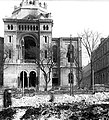Great Synagogue (Łódź)
The Great Synagogue , also known as the German Temple, was a free-standing sacred building of the reform-oriented Łódź Jewish community on the corner of Kościuszki / Zielona 9. The synagogue was higher than the surrounding urban development, an effect that was reinforced because it was built on a plinth has been. After the destruction in 1939, the property was not built over again, but serves as a parking lot and weekly market.
The construction was carried out in the years 1881 to 1887. The Stuttgart architect Adolf Wolff , whose last work it was, had planned several sacred buildings; here he oriented himself on a synagogue that he had previously designed for the Jewish community of Karlsbad . As a German architect he could only work in Poland in such a way that the urban architect Hilary Majewski signed his plans before they were presented to the authorities. Wolff died during the construction work.
The building was to a certain extent a private project of the industrialist Izrael Poznański . The architect Majewski designed a number of building projects in Łódź in the early years, including industrial villas. Right next to the synagogue, he built a villa for Poznański's daughter and his son-in-law Jakob Hertz (1892), the ground floor of which was designed in the style of a Venetian villa, while the upper floor was reminiscent of a French palace, while the gable and roof shape of the then modern Berliner Neo-baroque. In the case of the new synagogue, it was obviously important to the building committee that it was a purely European sacred architecture, a clear break with Orthodox Judaism, which was perceived as oriental. The eclectic structure combined elements of the Italian Renaissance with Romanesque and Byzantine forms.
Another member of the building committee was Markus Silberstein . On the occasion of the inauguration on September 15, 1887, he donated the curtain in front of the Torah shrine ( Parochet ), which was made of gold velvet. Among the non-Jewish guests at this service was the city governor, who was given the keys and then personally opened the synagogue door. Hermann Krüger gave the sermon in this festive service in Polish about the Bible verse: “My house will be called a house of prayer for all peoples”, Isa 56.7 EU . At the end of the service, the synagogue choir sang the national anthem of the Russian Empire , accompanied by an orchestra. A banquet followed with many representatives of the Christian business elite , including Karl Scheibler , who contributed 15,000 rubles to the construction of the synagogue (total cost: 225,000 rubles). The editors-in-chief of two Warsaw newspapers, Izraelita and HaTsefira , were also present; however, the Łódź city rabbi Elijahu Chaim Meisel stayed away from the celebration.
On the night of November 10-11, 1939, the Great Synagogue was burned down by Germans and the ruins were torn down in the spring of 1940.
View of the Torah shrine , the Bima and the Ner Tamid
Web links
- Bob Martens, Herbert Peter: Virtual Reconstruction of Synagogues in Lodz (Conference Paper, November 2016)
- 3D computer animation of the Łódź synagogue
Individual evidence
- ↑ David Schick: Trust, Religion, Ethnicity: The Economic Networks of Jewish Entrepreneurs in the Late Tsarist Empire . Vandenhoeck & Ruprecht, Göttingen 2017, p. 78.
- ^ Bob Martens, Herbert Peter: Virtual Reconstruction of Synagogues in Lodz , 2016, p. 187.
- ↑ Bob Martens, Herbert Peter: Virtual Reconstruction of Synagogues in Lodz , 2016, p. 190.
- ^ Bob Martens, Herbert Peter: Virtual Reconstruction of Synagogues in Lodz . Ktav, New Jersey, 2016, p. 189 f.
- ↑ Fredric Bedoire: The Jewish Contribution to Modern Architecture, 1830-1930 . Ktav, New Jersey 2004, p. 408.
- ↑ David Schick: Trust, Religion, Ethnicity: The Economic Networks of Jewish Entrepreneurs in the Late Tsarist Empire . Vandenhoeck & Ruprecht, Göttingen 2017, p. 78 f.
Coordinates: 51 ° 46 ′ 12.7 ″ N , 19 ° 27 ′ 13.3 ″ E






